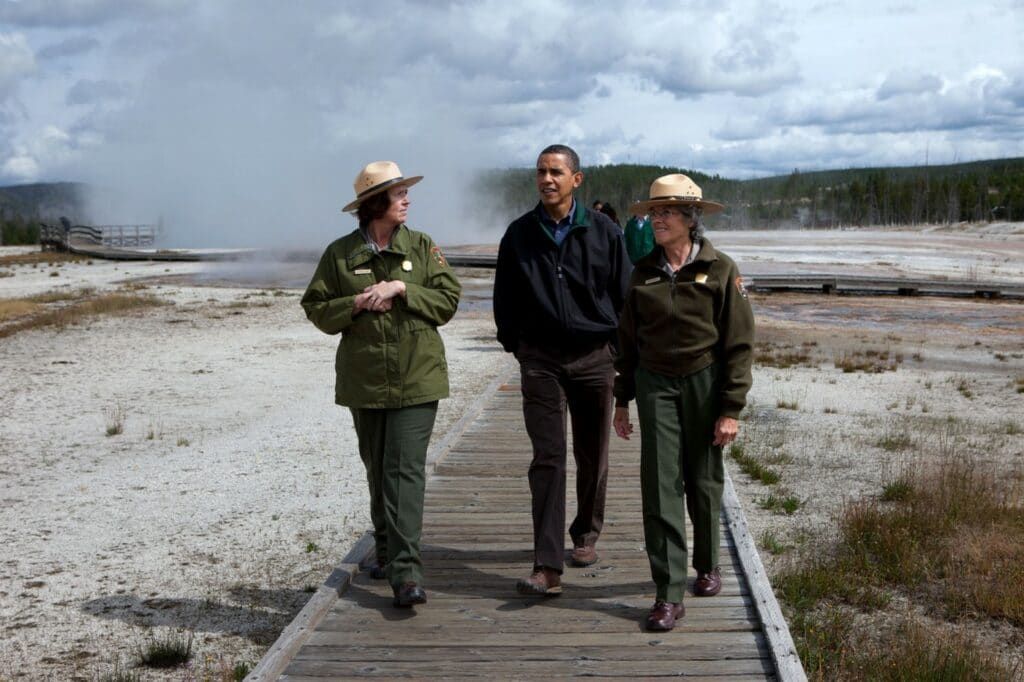When it comes to climate crisis, Obama’s new nature doc has no bite
By Jessica McKenzie | April 22, 2022
 Yellowstone National Park, Wyoming, Aug. 15, 2009. (Official White House photo by Pete Souza)
Yellowstone National Park, Wyoming, Aug. 15, 2009. (Official White House photo by Pete Souza)
Barack Obama has entered his David Attenborough phase, just in time for Earth Day. Higher Ground, the film production company founded by Barack and Michelle Obama with a multiyear deal with Netflix, released a new five-part docuseries earlier this month called “Our Great National Parks,” narrated by the former US president himself.
Visually, the series is exquisite. The choice to focus on national parks around the world was a smart one, both because it gives the project a unique angle in a crowded genre, and because Obama has a claim to fame when it comes to land conservation: As president, he added 22 new parks to the US National Park system and protected close to 550 million acres of habitat, more than any other US president in history. But the framing is also the series’ fatal flaw; at times, it seems Obama is taking a five-hour victory lap—not necessarily for his own conservation work, but for humanity’s. Of course, climate change is mentioned, but minimally; to say less about the crisis facing the world would verge on climate misinformation. And compared to other recent nature docuseries, like “Our Planet,” “Our Great National Parks” is downright regressive.
Several of the parks featured in the series were likely selected because of the personal connection Obama has with the places where they are located. The series opens with Obama strolling across a beach in Hawaii, where he was born; one episode features Tsavo National Park in Kenya, where his father was born and lived much of his life; another spotlights Gunung Leuser National Park in Indonesia, where Obama lived for several years as a child. The series is punctuated by personal reminiscences about these places and Obama’s relationship with nature in general.
The filmmakers managed to capture a rock iguana, only recently discovered and, Obama informs us, never before filmed, as well as a kind of flatworm “so new it’s yet to be named.” There’s a delightful and surprising shot of a Japanese macaque riding a miniature sika deer—how common can that be? There are also more people in this series than others of its kind, in part because many national parks are also places for outdoor recreation, or are located in close proximity to towns, villages, or even cities. But this is where the groundbreaking work of “Our Great National Parks” ends.
The series trades heavily on two nature documentary tropes: awe, and aww. There are many cute baby animals, so very many cute baby animals. In the first episode, a baby Von der Decken’s sifaka (a white-furred lemur with a black face) clings to its mother as she leaps across a field of towering, otherworldly limestone spires. A female puma hunts for her cubs, but when she strikes out, they feast on a carcass—one her daughter from a litter the year before stashed away for later. When the older sister comes back to reclaim her kill, she knocks her kid-brother into a mud puddle, unwilling to share any more meat. A sea otter swims around the docks of Monterey Bay, looking for a safe place to stash her hours-old pup while she hunts for shellfish. And then there’s the juvenile Andean condor learning to fly, which checks both “awe” and “aww” boxes.
The series hardly addresses how animals are adapting—or not—to a warming world. Instead, it mostly tells stories of incredible animals doing ordinary things to survive—like elephants finding water underground by smelling and digging with their trunks. Climate change is mentioned almost as a glancing afterthought, or a minor detail: “In recent years, Kenya’s climate has become less predictable and more extreme.” In the Patagonia episode, when the camera turns to brilliant glaciers, Obama says, “Relatively few of these icy giants remain,” without any mention of why that might be, or what it means for animals, ecosystems, or people.
The only scene in which Obama goes into greater detail about the threats to specific species due to climate change is in the first episode. He explains that the green sea turtles that nest on Raine Island are in dire straits. “Today, the accelerating pace of climate change is having a devastating impact,” Obama recites. “The hatchling’s sеx is determined by the temperature inside its nest. Hotter sands now mean that up to 99 percent of eggs that hatch here are female. And there’s more. As the planet warms and waters rise, nest sites can flood, drowning the eggs. With much of the beach just inches above sea level, Raine Island is at serious risk.”
This leads into Obama’s most forceful words on climate crisis in the whole series: “It’s been said that we’re the first generation to feel the impact of global warming, and the last that can do something about it. Our parks, like the rest of the planet, are now threatened by extreme weather, escalating pollution, and biodiversity and habitat loss.”
Obama avoids pointing fingers here, except to say, “Some of it, the result of the choices we all make in our daily lives” while the camera lingers on a pile of plastic bottles. What about the rest of it, Obama, hmm?
From there, he quickly shifts back to optimism: “We can turn things around,” he intones. “If we act now. In some protected places, we already have.” As evidence, he points to the recent protection of endangered mountain gorillas in Rwanda.
Strangely, Obama’s message is much less urgent now than it was in 2016, when he addressed the country from Yosemite. “Here in Yosemite, meadows are drying up, bird ranges are shifting farther northward, mammals are being forced further upslope,” Obama said then. “Yosemite’s famous glacier, once a mile wide, is almost gone. We are also facing longer, more expensive wildfire seasons.
“Rising temperatures could mean no more glaciers in Glacier national park, no more Joshua trees in Joshua Tree national park. Rising seas can destroy vital ecosystems in the Everglades and at some point could even threaten icons like the Statue of Liberty and Ellis Island. That’s not the America I want to pass on to the next generation.”
Obama rang a five-alarm fire then; why is he acting like saving the world is a fait accompli now?
Obama campaigned for president on a platform of hope, and hope is the prevailing message of “Our Great National Parks.” His narration projects competence, and calm. And yet in the face of climate crisis, calm and complacency are the last things the world needs.
Together, we make the world safer.
The Bulletin elevates expert voices above the noise. But as an independent nonprofit organization, our operations depend on the support of readers like you. Help us continue to deliver quality journalism that holds leaders accountable. Your support of our work at any level is important. In return, we promise our coverage will be understandable, influential, vigilant, solution-oriented, and fair-minded. Together we can make a difference.
Keywords: Barack Obama, biodiversity, climate crisis, global warming, mass media, national parks, review
Topics: Climate Change















Considering Obama’s softness on fracking, this documentary already rings hollow.